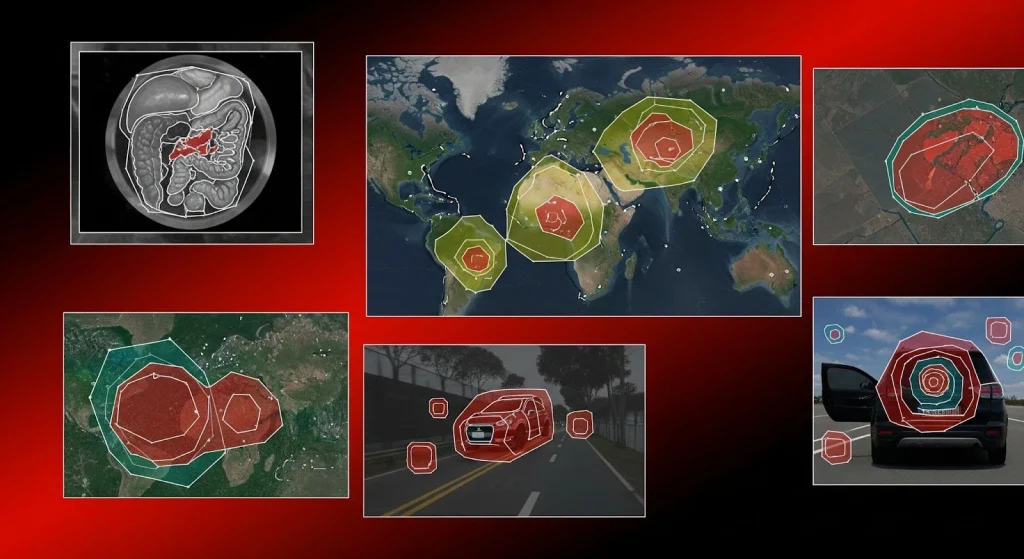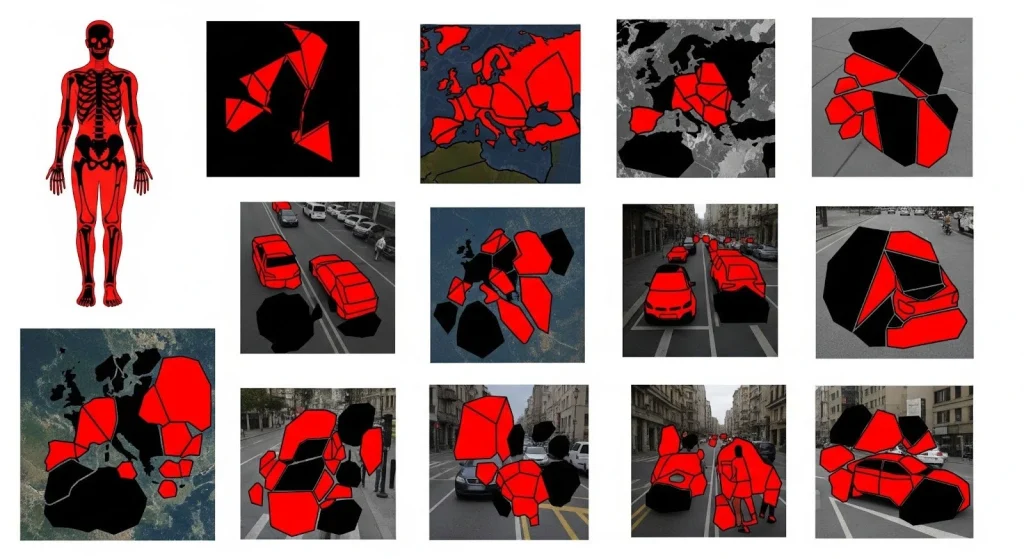In the rapidly evolving world of computer vision, polygon annotation has emerged as a cornerstone for training machine learning models to interpret and understand complex visual data. Unlike simpler methods like bounding boxes, polygon annotation offers pixel-perfect precision, making it essential for applications requiring detailed object detection and segmentation, such as autonomous vehicles, medical imaging, and agriculture. Our blog post will explore what polygon annotation is, how it works, and why it’s critical for advancing AI-driven solutions, with insights from our expertise in delivering high-quality annotation services.
What Is Polygon Annotation?
Polygon annotation is a data labeling technique used in computer vision to outline objects in images or videos by drawing multi-sided shapes, or polygons, around them. By connecting a series of points (vertices) along an object’s edges, annotators create a closed shape that precisely captures the object’s contours. This method is particularly effective for irregular or complex shapes, such as trees, vehicles, or anatomical structures, where bounding boxes may include unnecessary background noise.
Polygon annotation is foundational for tasks like object detection, instance segmentation, and semantic segmentation. It provides machine learning models with detailed information about an object’s shape, size, and position, enabling more accurate predictions and classifications. For instance, YOLO polygon annotation, including advanced versions like YOLOv8 polygon annotation, leverages polygons to enhance object detection performance by reducing irrelevant pixels.

Key Benefits of Polygon Annotation
- High Precision: Polygons tightly follow an object’s boundaries, capturing intricate details that bounding boxes miss. This is crucial for applications like tumor segmentation in medical imaging or aerial object mapping for drones.
- Versatility: Polygons can annotate objects of any shape, from simple traffic signs to complex organic forms, making them ideal for diverse industries.
- Improved Model Performance: By providing more accurate data, polygon annotations enhance model training for tasks like polygon object detection and segmentation annotation, leading to better real-world outcomes.
- Reduced Noise: Unlike bounding boxes, polygons exclude irrelevant background pixels, improving the signal-to-noise ratio in datasets.
- Flexibility for Augmentations: Polygons are more compatible with data augmentations like rotations, as they maintain a tight fit around objects, unlike axis-aligned bounding boxes.
How Does Polygon Annotation Work?
Polygon annotation involves a structured process to ensure accuracy and consistency. Here’s a step-by-step guide to how it works, drawing on our expertise in polygon annotation services:
- Selecting the Right Tool: Specialized polygon annotation tools, such as Labelbox, CVAT, or LabelImg, are mostly used to draw polygons around objects. These tools allow annotators like ours, to plot points along an object’s edges and connect them to form a closed shape. We leverage these advanced tools to ensure pinpoint accuracy, even for high-definition images with thousands of vertices.
- Drawing Polygons: Our annotators click multiple points along the object’s perimeter to create a polygon. For complex shapes, tools like Roboflow’s Smart Polygon (powered by the Segment Anything Model) or Supervisely’s enhanced polygon tool can automate parts of the process, speeding up annotation while maintaining precision.
- Labeling: Once the polygon is drawn, it is tagged with a descriptive label (e.g., “car,” “tumor,” or “crop”). This step is critical for training machine learning models to recognize and classify objects.
- Quality Control: To ensure high-quality datasets, our annotations undergo multiple stages of review and auditing. We employ strict quality control measures to maintain consistency and accuracy.
- Exporting Data: Our annotations are exported in formats like COCO, Pascal VOC, or YOLO, compatible with machine learning frameworks. For example, YOLO polygon detection requires annotations in a .txt file format with object class and coordinates.
Manual vs. Automated Polygon Annotation
- Manual Annotation: Annotators manually plot points using a graphical interface, ensuring high precision but requiring more time and skill. Tools like CVAT and Supervisely support features like zooming, panning, and free-hand drawing to streamline this process.
- Automated Annotation: Algorithms, such as those in Polygon-RNN++ or Mask-RCNN, can pre-label polygons, which annotators then refine. Automation reduces time but may need human review for complex shapes.
Use Cases of Polygon Annotation
Polygon annotation is critical across various industries due to its ability to handle complex shapes and provide pixel-perfect labeling. Here are some key applications, supported by our cross-sector expertise:
- Autonomous Vehicles: Polygons annotate road signs, lanes, and pedestrians with high precision, enabling safer navigation by reducing computational load and focusing on relevant data points.
- Medical Imaging: In oncology, polygons outline tumors in CT or MRI scans, aiding in accurate diagnosis and treatment planning.
- Geospatial Analysis: Drones and satellites use polygons to map irregular shapes like rooftops, forests, or land lots, enhancing urban planning and environmental monitoring.
- Agriculture: Polygons label crop rows, fruits, or disease symptoms, supporting yield analysis and plant disease identification. For example, we (Aya Data) built a dataset for maize disease identification using semantic segmentation, complementing polygon annotation.
- Retail and Visual Search: Polygons label products in shelf images or online catalogs, enabling visual search and shelf monitoring to improve customer experiences and inventory management.

Why Choose Aya Data for Polygon Annotations?
At Aya Data, we also specialise in polygon annotation services, that offers tailored solutions for industries like agriculture, healthcare, and autonomous driving etc.. Our team uses the best polygon labeling tools to deliver datasets with unparalleled accuracy, whether for object detection annotation or image segmentation annotation. Here’s why Aya Data stands out:
- Expertise Across Sectors: We understand when to use polygons versus bounding boxes, ensuring optimal annotation strategies for your project.
- Scalable Solutions: From small datasets to large-scale projects, we handle complex images with thousands of vertices.
- Advanced Tools: Our use of cutting-edge image annotation tools ensures efficiency and precision, even for polygonal annotation tasks.
- Quality Assurance: Multiple auditing stages guarantee high-quality datasets, critical for training robust AI models.
Challenges and Considerations
While polygon annotation offers unmatched precision, it can be time-consuming and requires skilled annotators, especially for intricate shapes. Automated tools like Roboflow’s Smart Polygon or Supervisely’s Auto-Select can mitigate this, but then, human oversight remains essential for quality control. Additionally, not all objects require polygons; simple shapes may perform well with bounding boxes, as they are quicker to annotate and sufficient for certain models.
Conclusion
Polygon annotation is one powerful technique that enhances the accuracy of computer vision models by providing detailed, pixel-perfect labeling for complex shapes. From polygon object detection in autonomous vehicles to image annotation for machine learning in healthcare, its applications are vast and transformative. Our expertise in polygon annotation services ensure that your datasets are precise, scalable, and ready to power cutting-edge AI solutions. Whether you’re exploring YOLO polygon detection or need a segmentation annotation tool, partnering with Aya Data guarantees high-quality results tailored to your business needs.
Ready to elevate your computer vision project? Contact us today to discuss your polygon annotation requirements and unlock the full potential of your AI models.
Frequently Asked Questions
What is polyline annotation?
Polyline annotation is the process of drawing continuous lines to mark or outline features in images or maps, often used for indicating paths, boundaries, or other linear features in computer vision and GIS applications
Why is it important to remove bias in data annotation?
Removing bias in data annotation is crucial because biased data can lead to skewed AI model predictions, perpetuating unfairness or discrimination in decision-making processes, impacting applications like hiring algorithms or predictive policing
What is a polygon feature in ArcGIS?
A polygon feature in ArcGIS represents an area on a map with a closed shape where each point is connected to form a boundary, used for land parcels, lakes, or any closed geographic area.
What are annotations in AutoCAD?
Annotations in AutoCAD include text, dimensions, leaders, and symbols that provide information or measurements on a drawing, enhancing its clarity and utility for design and construction purposes.
What is the purpose of using polygon in image annotation?
The purpose of using polygons in image annotation is to create detailed, multi-sided outlines around objects, enabling precise labeling for complex shapes. This supports accurate training of computer vision models for applications like autonomous driving and medical imaging.
What is one advantage of using polygons for image annotation?
One key advantage of using polygons for image annotation is their ability to precisely outline irregular shapes, capturing detailed object boundaries. This enhances accuracy in tasks like object detection and segmentation, reducing background noise and improving machine learning model performance.
In image annotation what is the purpose of using polygons?
In image annotation, the purpose of using polygons is to outline objects with high precision by connecting multiple points along their edges. This supports detailed segmentation and detection tasks, improving the performance of AI models in fields like healthcare and robotics.







